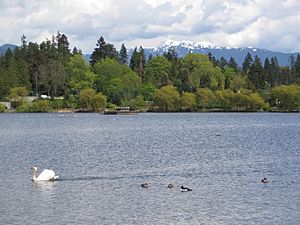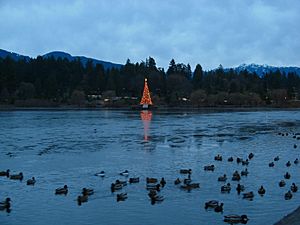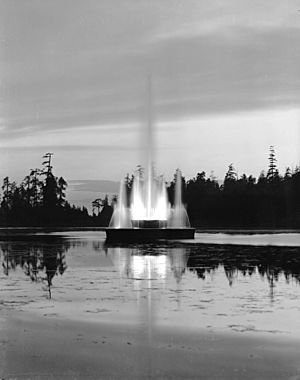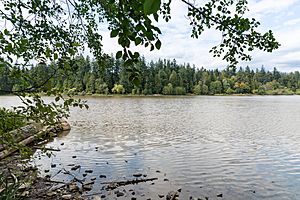Lost Lagoon facts for kids



Lost Lagoon is a human-made lake that's about 16.6 hectares (or 41 acres) big. It's located west of Georgia Street, close to the entrance of Stanley Park in Vancouver, British Columbia, Canada.
You can walk or run on a trail around the lake that's about 1.75 kilometers (1.09 miles) long. The lake also has a cool lit fountain. This fountain was put up by Robert Harold Williams to celebrate Vancouver's 50th birthday. Lost Lagoon is a popular spot for many birds, including mute swans, Canada geese, different kinds of ducks like mallard ducks, and great blue herons. You might also spot many turtles living on the northern shore.
History of Lost Lagoon
How Lost Lagoon Got Its Name
Long ago, Indigenous people gathered clams from the mudflats here when the tide was low. There's even a pile of old shells (called a midden) on the north side. This shows that a big home used to be there. In the Squamish language, its name is Ch'ekxwa'7lech, which means "gets dry at times."
Later, settlers built cabins around the lake. These cabins were taken down between 1913 and 1916 when the causeway was built. Lost Lagoon became a lake in 1916 when the Stanley Park causeway was built. Before that, it was just a shallow part of Coal Harbour, which connects to Burrard Inlet.
The name "Lost Lagoon" comes from a poem by Pauline Johnson. She explained that she didn't like the name "Coal Harbour." She loved to canoe in the sheltered cove. But when the tide went out, her favorite canoeing spot would disappear, or be "lost," for many days. So, she started calling it "Lost Lagoon."
The park board officially named it Lost Lagoon in 1922. This was after Pauline Johnson had passed away. It's a bit ironic because by then, the lagoon was no longer "lost" by the tides. It had become a permanent, landlocked lake.




